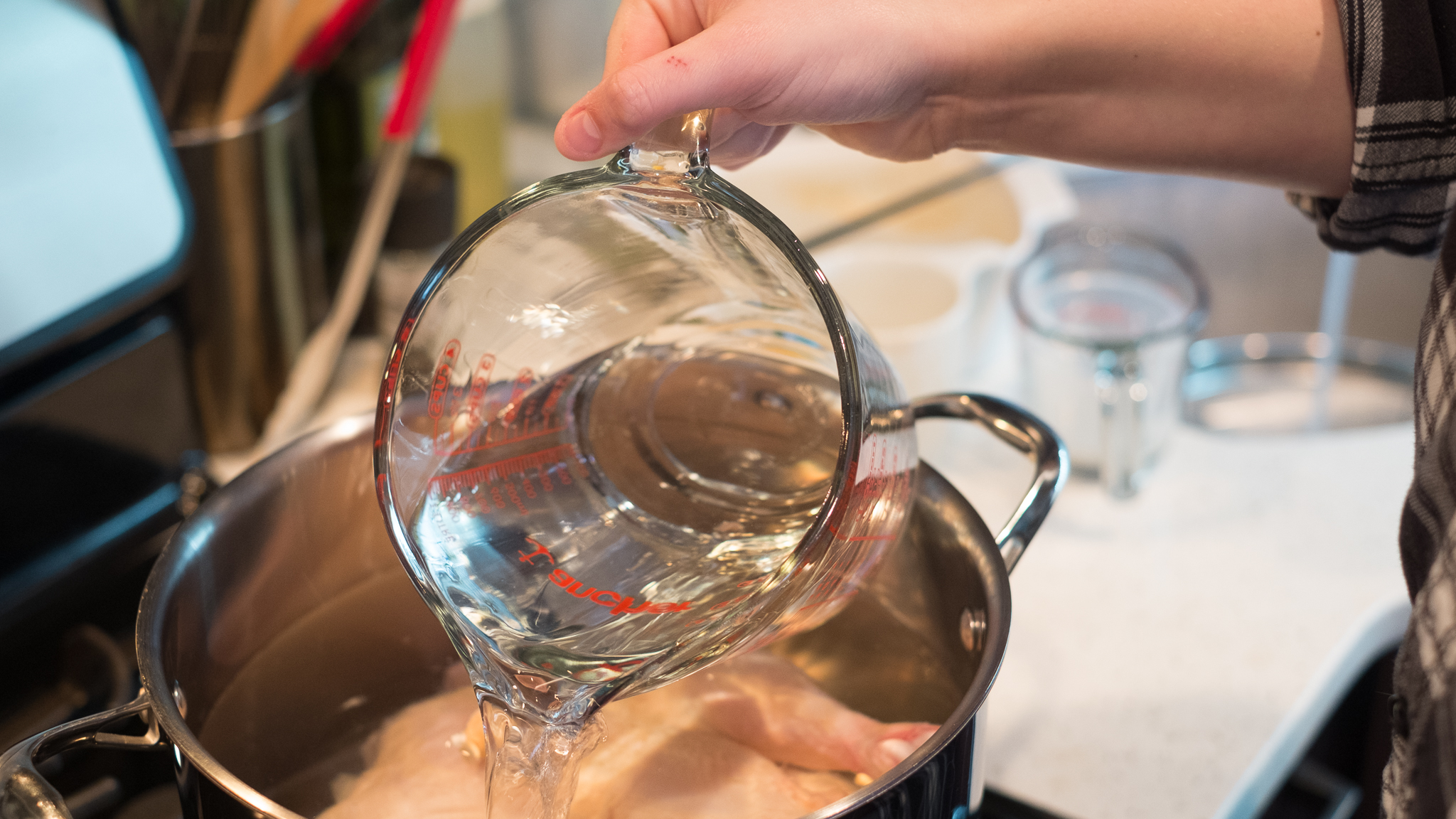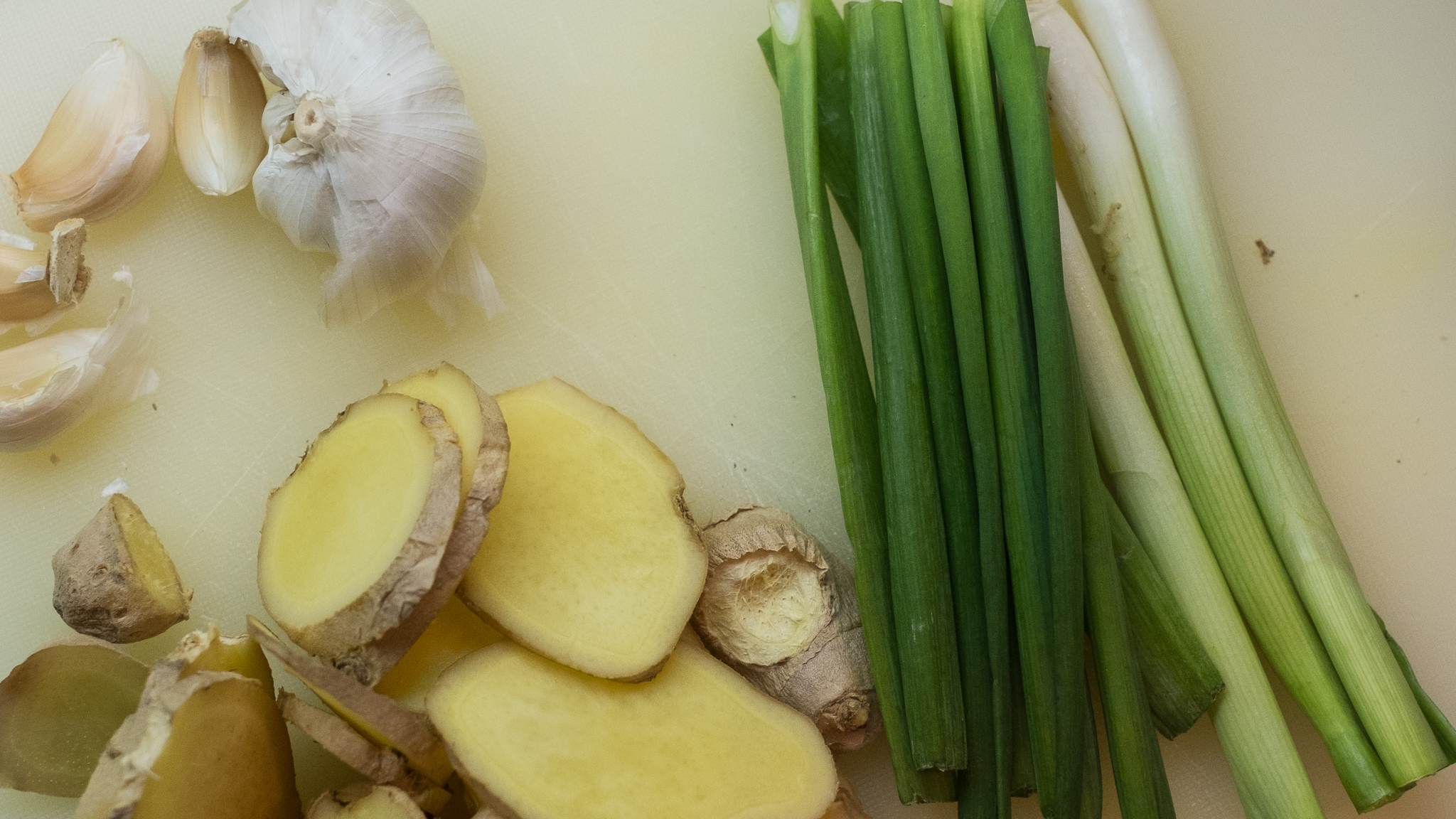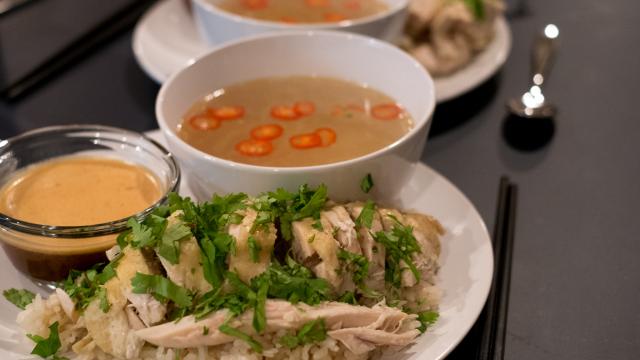If you read about cooking online, you’ve no doubt seen several listicles that tout the many uses of a single, humble chicken. At this point, you know what a chicken can do for you, so another overly-prescriptive, chicken-based meal plan seems unnecessary. My agenda here is very simple: the next time you buy a whole chicken, I want you to poach it.
Photo by Thomas Lawn.
Poaching is a criminally underrated technique, and chicken really takes to it. You need no special equipment: if you have a mixing bowl, a big pot with a lid, a mesh strainer, and storage containers for broth, you can do this. Better yet, poaching is foolproof in the way roasting isn’t and it pays more dividends: a whole bird’s worth of flavorful, juicy meat, a gallon of delicious broth, a carcass that can be simmered again for stock, and maybe even some rendered fat.
If you really miss that crispy skin, just press the wobbly, weird poached skin between two baking sheets and roast it to make tasty, tasty cracklins. It’s a time commitment – about five hours start-to-finish – but with just thirty minutes of active work, you can tackle this on a day off and still have plenty of downtime.
Step 1: Carefully Plan Your Meals
Getting multiple meals out of a single chicken is all in the planning. Make a list of meals for the week, starting with a big meal based around a poached chicken, and shop accordingly. I vouch for all of these recipes:
- Nong’s Khao Man Gai
- Chicken noodle or matzo ball soup
- Chicken & dumplings
- Red-cooked chicken
- Avgolemono
Serve either dark or white meat in the big first meal to maximise leftovers, but other than that, this is a choose-your-own-adventure story. Do you lose your mind for chicken salad sandwiches? Save the breasts for last and stock up on bread, duck-fat mayo, and crunchy veg. If you’d rather eat the white meat first and save the dark meat for, say, enchiladas, make sure you have tortillas, melty cheese, beans, and enchilada sauce on hand.
You’ll also have a gallon each of broth and stock to work with, so pick up plenty of soup, stew, and/or risotto ingredients. Speaking of stock, don’t forget root vegetables and aromatics – I especially recommend some parsnips.
Step 2: Poach The Chicken (and Make Stock)
Take the chicken out of its packaging. Remove any giblets and trim the excess skin around the cavity. Render the trimmings if you like; discard the giblets or save for another project.
Cover the chicken in plastic wrap and let it come to room temperature, which takes an hour or two. (Starting a room temperature chicken in room temperature water ensures it cooks all the way through, so don’t skip this step!) Meanwhile, prepare the other ingredients – I made khao man gai, so I sliced some ginger, lopped the head off some garlic, and measured out my salt and sugar.
Once it’s warmed up, place the chicken in a bowl (or colander) in the sink and dump a handful of salt on top. Rub all over with the salt, including inside the cavity, then give it a good rinse. Exfoliated chicken sounds like a Goop fever-dream, but a salt scrub removes any lingering skin-gunk – which makes for clearer, tastier broth. (Skip this step if you’re using a kosher chicken.)

Photo by Thomas Lawn.
Lower the chicken into the pot so the cavity points up. Fill the cavity with tepid water first, then add enough water to cover the chicken by a few inches. Check to make sure the cavity is completely full and nudge your chicken around until it rests breast side up.

Photo by Thomas Lawn.
Add the seasonings and cover the pot. Bring to a rolling boil over medium-high heat, then reduce the heat and cook at a low simmer for 25-30 minutes. Cut the heat and let the chicken steep in its broth, covered, for two to four hours. A long steep produces succulent meat and richly-flavored broth without any of the gunk you get from boiling animal parts in water.
When it’s cooled to your liking, take the chicken out of the pot. I find it easiest to stick a sturdy, long-handled spoon in the cavity and gently tilt it upwards – so you’re looking down its neck rather than up its butt – then gradually lift the chicken out, using another spoon or tongs for extra support if needed. This way, the liquid inside the cavity drains back into the pot.
Put your chicken on a cutting board and let it rest while you strain the broth, then use half the poached chicken meat and all the broth you need to prepare the rest of your meal. After dinner, pick the carcass clean and save everything: meat for future meals, skin and bones and carcass for stock. If you’re tired of waiting around to strain hot liquids, make stock tomorrow.
Step 3: Profit
If you’ve never had poached chicken before, you might be suspicious of what’s on your plate — especially if you made khao man gai or red-cooked chicken, which really feature the poached meat. How can chicken cooked in water possibly taste good, let alone indulgent?
The secret, as I implied earlier, is all in the steep. Letting the chicken finish cooking in a closed pot full of gradually-cooling water infuses the broth with maximum flavour, which in turn provides the perfect environment for tender, flavorful meat.
Steeping the chicken whole also ensures that whatever is left on the carcass has plenty of goodness left for stock. This is why I poach chickens slowly on the stovetop rather than quickly in my three-quart Instant Pot, which is too small to quench my broth-lust. (It does make great stock, though.)
Some good things take time, and poached chicken is absolutely one of them; after a few meals made with its spoils, I think you’ll agree.

Comments